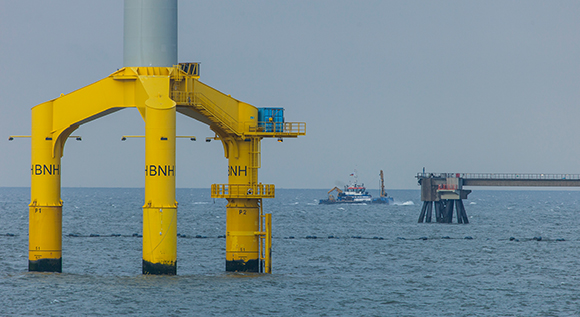Procurement procedure started: Bringing off-shore wind power installations online
More and more wind turbines are spinning their rotors off the German coasts. But how do you get the electricity from there on line? On 1 April, the German regulatory authority, the Federal Network Agency, launched the second procurement procedure for allocating connection capacity to the wind parks in the North and Baltic Seas.
 © BMWi/ Holger Vonderlind
© BMWi/ Holger Vonderlind
The same applies at sea as on land: No electricity can flow without a power line. So erecting wind parks off the coasts is only worthwhile if they can also be connected to the electricity grid and feed in their output. This takes two partners: While investors carry out and finance the construction of these off-shore wind parks, transmission system operators are responsible for grid expansion.
In 2012, the Offshore Grid Development Plan was introduced to better coordinate construction and grid connections: It sets out the demand for power lines for the next ten years and a schedule for implementation. This plan is drawn up by the transmission system operators. They then convey it to the Federal Network Agency, which assesses it in consultation with the Federal Office of Maritime Navigation and Hydrography and finally approves it. Under the Energy Industry Act (EnWG), the Federal Network Agency is also responsible for allocating free line capacities and connection capacities in the North and Baltic Seas to the off-shore wind parks - in an objective, transparent and non-discriminatory procedure.
Second procurement procedure underway
As of 1 April, the Federal Network Agency has meanwhile opened the second procurement procedure. Investors in existing or planned wind parks can apply by 6 May to take part. The Federal Network Agency will then decide on applications. If the demand for connection capacities exceeds current supply, an auction will be held.
How does the procedure work?
The Federal Network Agency first announces which connection capacities are available for linking the wind parks to the power grid. In the current procedure, these amount to 211 megawatts (MW). It arrives at this figure with a simple calculation: By law, up to 2020 the Federal Network Agency may grant a maximum of 7,700 megawatts of grid connection capacity, almost 6,000 megawatts of which have already been committed. In the first procurement procedure last year, over 1,500 megawatts were allocated, leaving 211 MW.
Binding expansion targets for more planning certainty
The statutory ceiling of 7,700 megawatts in grid connection capacity that the Federal Network Agency may grant is in keeping with the deployment targets of the Federal Government. This also includes raising installed off-shore capacity from almost 3,000 megawatts at present to 6,500 megawatts in 2020. These binding provisions enable the Agency to better estimate the costs for consumers who pay for the expansion of off-shore wind power and its connection to the power grid via the EEG surcharge and grid charges. They also give operators and investors more planning certainty.
Major role in the energy sector
This certainty is important to expedite the expansion, because although off-shore wind turbines are more expensive and more complicated to erect than on-shore wind power installations, they have a decisive advantage: As the wind almost always blows at sea - and also considerably stronger than on shore - the installations can supply electricity almost every hour in the year. This is also quite easy to quantify. Off-shore installations can therefore play a major role for the energy industry: They can guarantee a reliable supply of electricity even when the sun does not shine and no wind blows on shore.

